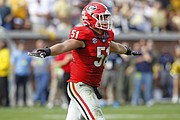Smithsonian puts focus back on Scopes Trial photos
Thursday, July 14, 2011
It's time to pull out your family photo albums and start thinking like a historian.
In anticipation of the 86th anniversary of the Scopes Trial, archivists from the Smithsonian Institution have released 11 photos taken in nearby Dayton, Tenn., during the famous anti-evolution legal case of the 1920s. The photos feature people who can't be identified by archivists.
They hope that by putting the photos on the photo-sharing website Flickr, people may recognize the subjects and help the Smithsonian learn more about them.
"There's certain figures [in the photos] that we really like, and we've given them nicknames," said Tammy Peters, a supervisory archivist at the Smithsonian Institution Archives. "We've mused about why they might have been there, or who they are.
"I've always wanted to throw these out to people around Dayton to see if anyone might recognize them. ... We thought now is the time to see if people can help us."
One of the photos features a young girl leaning against a bicycle rack, while another shows famed defense attorney Clarence Darrow, who defended Scopes, holding a Chattanooga newspaper and standing next to an unidentified man.
If anyone recognizes the unidentified subjects in the photos, Peters said, they can comment on the Smithsonian Institution Archives' blog post about the photos or on the photos themselves on Flickr.
Several years ago, Peters said archivists posted photos of unidentified female scientists on Flickr and had some success learning more about the subjects. They hope for similar results this time.
"Ideally, we'd like to know as much as we can [about our photos]," she said. "They really come to life. If we can add information, that would be ideal."
But Tom Davis, spokesman for Dayton's Bryan College and a former director of the yearly Scopes Trial Festival, said he's not sure how much additional information the Smithsonian will be able to find.
"I think it's a great idea. It's one of these things that, who knows? Maybe somebody's grandson or granddaughter would recognize them," Davis said. "But 80 some years after the fact, you're really at a dead end otherwise."
Although there are no specific plans in place, Peters said the photos that archivists are trying to identify could one day become part of an online exhibit or a smaller exhibit at the National Museum of American History.

